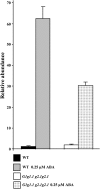Arabidopsis plants deficient in plastidial glyceraldehyde-3-phosphate dehydrogenase show alterations in abscisic acid (ABA) signal transduction: interaction between ABA and primary metabolism
- PMID: 21068209
- PMCID: PMC3022406
- DOI: 10.1093/jxb/erq353
Arabidopsis plants deficient in plastidial glyceraldehyde-3-phosphate dehydrogenase show alterations in abscisic acid (ABA) signal transduction: interaction between ABA and primary metabolism
Abstract
Abscisic acid (ABA) controls plant development and regulates plant responses to environmental stresses. A role for ABA in sugar regulation of plant development has also been well documented although the molecular mechanisms connecting the hormone with sugar signal transduction pathways are not well understood. In this work it is shown that Arabidopsis thaliana mutants deficient in plastidial glycolytic glyceraldehyde-3-phosphate dehydrogenase (gapcp1gapcp2) are ABA insensitive in growth, stomatal closure, and germination assays. The ABA levels of gapcp1gapcp2 were normal, suggesting that the ABA signal transduction pathway is impaired in the mutants. ABA modified gapcp1gapcp2 gene expression, but the mutant response to the hormone differed from that observed in wild-type plants. The gene expression of the transcription factor ABI4, involved in both sugar and ABA signalling, was altered in gapcp1gapcp2, suggesting that their ABA insensitivity is mediated, at least partially, through this transcriptional regulator. Serine supplementation was able partly to restore the ABA sensitivity of gapcp1gapcp2, indicating that amino acid homeostasis and/or serine metabolism may also be important determinants in the connections of ABA with primary metabolism. Overall, these studies provide new insights into the links between plant primary metabolism and ABA signalling, and demonstrate the importance of plastidial glycolytic glyceraldehyde-3-phosphate dehydrogenase in these interactions.
Figures








Similar articles
-
Interactions between abscisic acid and plastidial glycolysis in Arabidopsis.Plant Signal Behav. 2011 Jan;6(1):157-9. doi: 10.4161/psb.6.1.14312. Epub 2011 Jan 1. Plant Signal Behav. 2011. PMID: 21248489 Free PMC article.
-
Overexpression of the triose phosphate translocator (TPT) complements the abnormal metabolism and development of plastidial glycolytic glyceraldehyde-3-phosphate dehydrogenase mutants.Plant J. 2017 Mar;89(6):1146-1158. doi: 10.1111/tpj.13452. Epub 2017 Feb 11. Plant J. 2017. PMID: 27984670
-
Interaction between sugar and abscisic acid signalling during early seedling development in Arabidopsis.Plant Mol Biol. 2008 May;67(1-2):151-67. doi: 10.1007/s11103-008-9308-6. Epub 2008 Feb 17. Plant Mol Biol. 2008. PMID: 18278579 Free PMC article.
-
Multifaceted Signaling Networks Mediated by Abscisic Acid Insensitive 4.Plant Commun. 2020 Mar 7;1(3):100040. doi: 10.1016/j.xplc.2020.100040. eCollection 2020 May 11. Plant Commun. 2020. PMID: 33367237 Free PMC article. Review.
-
The SnRK1 Kinase as Central Mediator of Energy Signaling between Different Organelles.Plant Physiol. 2018 Feb;176(2):1085-1094. doi: 10.1104/pp.17.01404. Epub 2018 Jan 8. Plant Physiol. 2018. PMID: 29311271 Free PMC article. Review.
Cited by
-
TaWRKY40 transcription factor positively regulate the expression of TaGAPC1 to enhance drought tolerance.BMC Genomics. 2019 Oct 30;20(1):795. doi: 10.1186/s12864-019-6178-z. BMC Genomics. 2019. Retraction in: BMC Genomics. 2023 Apr 6;24(1):187. doi: 10.1186/s12864-023-09289-2. PMID: 31666006 Free PMC article. Retracted.
-
Cytosolic glyceraldehyde-3-phosphate dehydrogenases interact with phospholipase Dδ to transduce hydrogen peroxide signals in the Arabidopsis response to stress.Plant Cell. 2012 May;24(5):2200-12. doi: 10.1105/tpc.111.094946. Epub 2012 May 15. Plant Cell. 2012. PMID: 22589465 Free PMC article.
-
Integrating Proteomics and Metabolomics Approaches to Elucidate the Mechanism of Responses to Combined Stress in the Bell Pepper (Capsicum annuum).Plants (Basel). 2024 Jul 5;13(13):1861. doi: 10.3390/plants13131861. Plants (Basel). 2024. PMID: 38999705 Free PMC article.
-
Jasmonate signaling involves the abscisic acid receptor PYL4 to regulate metabolic reprogramming in Arabidopsis and tobacco.Proc Natl Acad Sci U S A. 2011 Apr 5;108(14):5891-6. doi: 10.1073/pnas.1103010108. Epub 2011 Mar 21. Proc Natl Acad Sci U S A. 2011. PMID: 21436041 Free PMC article.
-
Genome-wide identification and characterization of Glyceraldehyde-3-phosphate dehydrogenase genes family in wheat (Triticum aestivum).BMC Genomics. 2016 Mar 16;17:240. doi: 10.1186/s12864-016-2527-3. BMC Genomics. 2016. PMID: 26984398 Free PMC article.
References
-
- Acevedo-Hernandez GJ, Leon P, Herrera-Estrella LR. Sugar and ABA responsiveness of a minimal RBCS light-responsive unit is mediated by direct binding of ABI4. The Plant Journal. 2005;43:506–519. - PubMed
-
- Akihiro T, Mizuno K, Fujimura T. Gene expression of ADP-glucose pyrophosphorylase and starch contents in rice cultured cells are cooperatively regulated by sucrose and ABA. Plant and Cell Physiology. 2005;46:937–946. - PubMed
Publication types
MeSH terms
Substances
Grants and funding
LinkOut - more resources
Full Text Sources
Molecular Biology Databases
Research Materials

